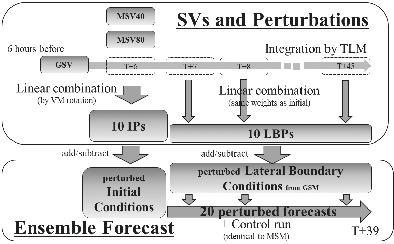当前位置:
X-MOL 学术
›
Q. J. R. Meteorol. Soc.
›
论文详情
Our official English website, www.x-mol.net, welcomes your feedback! (Note: you will need to create a separate account there.)
The regional model‐based Mesoscale Ensemble Prediction System, MEPS, at the Japan Meteorological Agency
Quarterly Journal of the Royal Meteorological Society ( IF 8.9 ) Pub Date : 2020-10-04 , DOI: 10.1002/qj.3928 Kosuke Ono 1, 2 , Masaru Kunii 2 , Yuki Honda 3
Quarterly Journal of the Royal Meteorological Society ( IF 8.9 ) Pub Date : 2020-10-04 , DOI: 10.1002/qj.3928 Kosuke Ono 1, 2 , Masaru Kunii 2 , Yuki Honda 3
Affiliation

|
The regional model‐based Mesoscale Ensemble Prediction System (MEPS) has been operational since June 2019 at the Japan Meteorological Agency (JMA). The primary objective of the newly operational MEPS is to provide uncertainty information for JMA's operational regional model, Mesoscale Model (MSM), which provides information to support disaster prevention and aviation safety. This article describes MEPS in detail and discusses issues to be addressed in the future. For effective evaluation of uncertainties in MSM, the forecast model in MEPS is configured in the same way as that in MSM, except for the initial and lateral boundary conditions. Initial perturbations for all 20 ensemble runs are generated by a linear combination of singular vectors (SVs) with three different spatial and temporal resolutions, with the aim of capturing multi‐scale uncertainties in the initial conditions simultaneously. The SVs from a global model are also used as lateral boundary perturbations to ensure consistency between the initial and boundary conditions of each ensemble member. The verification results showed that MEPS achieved the expected performance of an ensemble prediction system: the ensemble mean outperformed the control forecast with a good spread–skill relationship; moreover, the skill scores of probabilistic precipitation forecasts were evaluated as valid for rainfall of up to 30 mm·(3 hr)−1. In an additional experiment conducted without using the two smaller‐scale initial perturbations, the skill was substantially reduced compared with that of the original MEPS, especially for larger precipitation thresholds. Therefore, the smaller‐scale perturbations were essential to capture uncertainties associated with local heavy rainfall events.
中文翻译:

日本气象厅基于区域模型的中尺度集合预报系统MEPS
基于区域模型的中尺度集合预报系统(MEPS)自2019年6月起在日本气象厅(JMA)开始运行。新运行的MEPS的主要目标是为JMA的运行区域模型Mesoscale模型(MSM)提供不确定性信息,该模型提供信息以支持防灾和航空安全。本文详细介绍了MEPS,并讨论了将来需要解决的问题。为了有效评估MSM中的不确定性,除了初始和横向边界条件外,MEPS中的预测模型的配置方式与MSM中相同。通过对具有三种不同时空分辨率的奇异矢量(SV)进行线性组合,可以生成所有20个合奏运行的初始摄动,目的是同时捕获初始条件下的多尺度不确定性。全局模型中的SV也用作横向边界扰动,以确保每个集合成员的初始条件和边界条件之间的一致性。验证结果表明,MEPS达到了集成预测系统的预期性能:集成均值以良好的传播与技能关系优于控制预测。此外,概率降水预报的技能得分被评估为对最大30 mm·(3 hr)的降雨有效 验证结果表明,MEPS达到了集成预测系统的预期性能:集成均值以良好的传播与技能关系优于控制预测。此外,概率降水预报的技能得分被评估为对最大30 mm·(3 hr)的降雨有效 验证结果表明,MEPS达到了集成预测系统的预期性能:集成均值以良好的传播与技能关系优于控制预测。此外,概率降水预报的技能得分被评估为对最大30 mm·(3 hr)的降雨有效-1。在不使用两个较小规模的初始扰动的情况下进行的另一项实验中,与原始MEPS相比,该技术已大大降低,尤其是对于较大的降水阈值。因此,较小的扰动对于捕获与当地强降雨事件相关的不确定性至关重要。
更新日期:2020-10-04
中文翻译:

日本气象厅基于区域模型的中尺度集合预报系统MEPS
基于区域模型的中尺度集合预报系统(MEPS)自2019年6月起在日本气象厅(JMA)开始运行。新运行的MEPS的主要目标是为JMA的运行区域模型Mesoscale模型(MSM)提供不确定性信息,该模型提供信息以支持防灾和航空安全。本文详细介绍了MEPS,并讨论了将来需要解决的问题。为了有效评估MSM中的不确定性,除了初始和横向边界条件外,MEPS中的预测模型的配置方式与MSM中相同。通过对具有三种不同时空分辨率的奇异矢量(SV)进行线性组合,可以生成所有20个合奏运行的初始摄动,目的是同时捕获初始条件下的多尺度不确定性。全局模型中的SV也用作横向边界扰动,以确保每个集合成员的初始条件和边界条件之间的一致性。验证结果表明,MEPS达到了集成预测系统的预期性能:集成均值以良好的传播与技能关系优于控制预测。此外,概率降水预报的技能得分被评估为对最大30 mm·(3 hr)的降雨有效 验证结果表明,MEPS达到了集成预测系统的预期性能:集成均值以良好的传播与技能关系优于控制预测。此外,概率降水预报的技能得分被评估为对最大30 mm·(3 hr)的降雨有效 验证结果表明,MEPS达到了集成预测系统的预期性能:集成均值以良好的传播与技能关系优于控制预测。此外,概率降水预报的技能得分被评估为对最大30 mm·(3 hr)的降雨有效-1。在不使用两个较小规模的初始扰动的情况下进行的另一项实验中,与原始MEPS相比,该技术已大大降低,尤其是对于较大的降水阈值。因此,较小的扰动对于捕获与当地强降雨事件相关的不确定性至关重要。


























 京公网安备 11010802027423号
京公网安备 11010802027423号